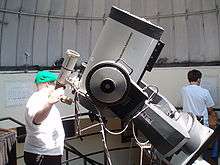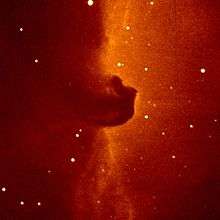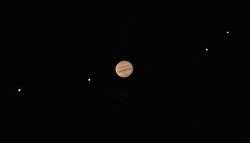Meade LX200
The Meade LX200 is a family of commercial telescopes produced by Meade Instruments launched in 1992 with 8" (20.32 cm) and a 10" (25.4 cm) Schmidt–Cassegrain models on computerized altazimuth mounts.[1][2] Two larger models, a 12" (30.48 cm) and a 16" (40.64 cm), quickly followed. The original version was later informally named the "classic" LX200 as newer upgraded versions replaced it.[3] The first of these was the LX200GPS, which featured global positioning system electronics.[3] A 360 mm (14 in) LX200GPS was later added to the line.
 A 16" (406.4 mm) aperture Meade LX200 in the York University Observatory | |
| Telescope style | optical telescope |
|---|---|
| Diameter | 14 in (0.36 m) |
| Website | www |




The advantage of the LX200 was price for its performance, which was accomplished by using electronics and software to equal the pointing performance of more expensive systems.[2] Software and optical encoders corrected for errors, and the telescope also came with auto-guiding CCD and planetarium software.[2]
A related series introduced in 2005 was the even higher end RCX400 (later renamed LX400-ACF), with new optics and a motorized focus/collimation system, and with upgraded fork mount electronics.[4] These were available in the same 8" (20.32 cm) to 16" (40.64) size range on the new fork mount, and the 16" (40.64 cm) optical tube assembly (OTA), along with a new 20" (50.8 cm) OTA, were available on a new German equatorial mount. These were all f/8 optical systems, costing up to $50,000 for the 20" on the German equatorial mount.[5]
An f/10 version of the new optics later replaced the optics of the existing LX200GPS fork mount models, with the new product line now called the LX200R (later renamed LX200-ACF).[3] The revised optics are called advanced coma free (ACF) after a lawsuit by Star Instruments and RC Optical Systems disallowed implying that they were based on Ritchey–Chrétien optics.[6]
In September 2012, an amateur astronomer used an LX200GPS to record an impact on the planet Jupiter.[7]
Installations
Selected observatories with LX200 telescopes.
- Grupo de Dinâmica Orbital e Planetologia da UNESP de Guaratinguetá
- Observatório da Universidade de Brasília at Universidade de Brasília
- Observatorio de la Universidad Tecnológica de Pereira
- Mount Wilson Observatory (prototype version)
- Ball State University Observatory
- Barus & Holley Observatory
- Bayfordbury Observatory (University of Hertfordshire Observatory)
- Bradstreet Observatory
- Campbelltown Rotary Observatory
- California Polytechnic State University in San Luis Obispo
- Clavius Observatory, Universidad IberoAmericana, Mexico City, Mexico, www.clavius.astro.org.mx
- Collins Observatory at Salem State University
- Dodge City Community College
- David Cole Observatory
- Foothill Observatory (at Foothill College)
- Frosty Drew Observatory
- Givatayim Observatory
- Hereford Arizona Observatory
- Junk Bond Observatory
- Letchworth & District Astronomical Society
- Mead Observatory
- AMJOCH Observatory at Michigan Technological University
- Mount Albert Grammar School Observatory
- Northumberland Astronomical Society
- Nyrölä Observatory
- Observatoire des Sciences de l'Univers de Grenoble
- Observatorio Astronómico de Mallorca
- Observatório Astronômico da UESC
- Perth Observatory
- Project Galileo
- Red Barn Observatory
- Rochester Institute of Technology
- Science Education Observatory, Seoul National University, Seoul, South Korea
- Shattuck Observatory
- La Société Vaudoise des Sciences Naturelles - Lausanne, Switzerland
- Starkenburg Observatory
- Telus World of Science (Edmonton)
- TUBITAK National Observatory
- Van Vleck Observatory
- West Yorkshire Astronomical Society
- Widener University Observatory
- Yale Student Observatory
- York University Observatory
- Universidad de Sonora, Mexico
- Astronomical centre Rijeka
- Saint Joseph Catholic School Student Observatory, Madison, Mississippi, USA
- Harold E. Taylor Observatory at the Richard Stockton State College of New Jersey
- Observatoire du mont cosmos
- Jiamusi University Observatory
References
- Rod Mollise – "The Past, Present and Future of the Schmidt Cassegrain Telescope" (ALCON 2003/Nashville), Power Point (.ppt)
- Martin Mobberley (2004). The New Amateur Astronomer. Springer Science & Business Media. p. 34. ISBN 978-1-85233-663-9.
- Lawrence Harris (2010). So You Want a Meade LX Telescope!: How to Select and Use the LX200 and Other High-End Models. Springer Science & Business Media. p. 17. ISBN 978-1-4419-1775-1.
- https://www.skyandtelescope.com/astronomy-equipment/meades-rcx400-raisingthe-bar/
- Durango Skies – LX400-ACF 20" (f/8) w/UHTC on MAX Mount w/Tripod Archived 2011-04-29 at the Wayback Machine
- RC vs Meade
- A Fresh Impact on Jupiter
External links
| Wikimedia Commons has media related to Meade LX200. |